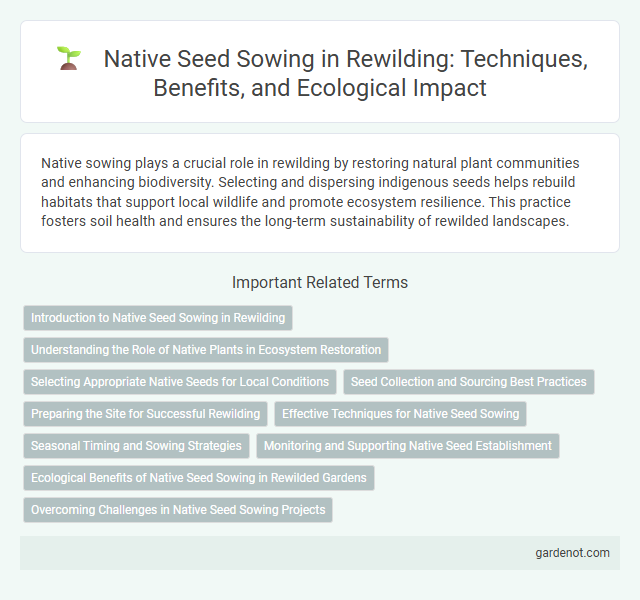Native sowing plays a crucial role in rewilding by restoring natural plant communities and enhancing biodiversity. Selecting and dispersing indigenous seeds helps rebuild habitats that support local wildlife and promote ecosystem resilience. This practice fosters soil health and ensures the long-term sustainability of rewilded landscapes.
Introduction to Native Seed Sowing in Rewilding
Native seed sowing plays a crucial role in rewilding by restoring natural plant communities and enhancing biodiversity. Using region-specific seeds supports ecosystem resilience and promotes habitat for native wildlife. Effective native seed sowing requires understanding local soil conditions, seed dormancy, and seasonal timing for optimal germination and growth.
Understanding the Role of Native Plants in Ecosystem Restoration
Native sowing plays a critical role in ecosystem restoration by reintroducing species specifically adapted to local conditions, enhancing biodiversity, and stabilizing soil health. These plants support native wildlife by providing essential habitats and food sources, fostering balanced ecological interactions. Incorporating native species accelerates natural succession processes, promoting resilient and self-sustaining landscapes.
Selecting Appropriate Native Seeds for Local Conditions
Selecting appropriate native seeds for rewilding projects involves prioritizing local provenance to enhance ecosystem resilience and biodiversity. Native seeds adapted to specific soil types, climate patterns, and hydrological conditions increase establishment success and support native wildlife. Using regionally sourced seeds reduces the risk of introducing maladapted genotypes and promotes genetic diversity within native plant populations.
Seed Collection and Sourcing Best Practices
Native sowing relies on careful seed collection from local, genetically diverse plant populations to maintain ecosystem resilience and adaptability. Optimal sourcing involves timing harvests when seeds reach full maturity and ensuring minimal disturbance to parent plants and surrounding habitats. Employing best practices like using clean equipment and storing seeds under controlled conditions preserves viability for successful rewilding projects.
Preparing the Site for Successful Rewilding
Preparing the site for successful rewilding involves removing invasive species and restoring native soil conditions to support native sowing. Enhancing soil fertility with organic matter and ensuring proper sunlight exposure promotes the germination of indigenous plant seeds. Careful site assessment and habitat connectivity optimize growth, increasing biodiversity and ecological resilience.
Effective Techniques for Native Seed Sowing
Effective techniques for native seed sowing significantly enhance rewilding success by improving seed germination and establishment. Methods such as stratification mimic natural seasonal cycles to break seed dormancy, while seed scarification aids in penetrating tough seed coats for better moisture absorption. Combining precise seedbed preparation, appropriate sowing depth, and timing aligned with local climate conditions ensures optimal native plant growth and ecosystem restoration.
Seasonal Timing and Sowing Strategies
Optimal native sowing hinges on understanding seasonal timing, with early spring and late autumn providing ideal moisture and temperature conditions promoting germination. Sowing strategies prioritize seed-soil contact through shallow broadcasting and light raking, enhancing establishment rates. Selecting native species with staggered germination periods ensures continuous ground cover and resilience against climatic variability.
Monitoring and Supporting Native Seed Establishment
Monitoring native seed establishment involves regular assessments of seed germination rates, seedling survival, and growth patterns in rewilding sites. Supporting native sowing includes soil preparation, protection from invasive species, and adaptive management to enhance seedling resilience and biodiversity recovery. Effective monitoring guides timely interventions, ensuring robust native plant populations and ecosystem restoration.
Ecological Benefits of Native Seed Sowing in Rewilded Gardens
Native seed sowing in rewilded gardens enhances biodiversity by supporting local pollinators, birds, and beneficial insects, creating a self-sustaining ecosystem. The deep root systems of native plants improve soil health by preventing erosion and increasing water infiltration. These plants also adapt to regional climate conditions, reducing the need for irrigation and chemical inputs, which promotes ecological balance and resilience.
Overcoming Challenges in Native Seed Sowing Projects
Native seed sowing projects face challenges including soil degradation, invasive species competition, and variable climate conditions that hinder germination and plant establishment. Employing site-specific seed mixes, preparing seedbeds through minimal soil disturbance, and using pre-sowing treatments like scarification enhance germination rates. Collaboration with local ecologists and long-term monitoring ensures adaptive management and successful restoration of native plant communities.
Native sowing Infographic

 gardenot.com
gardenot.com